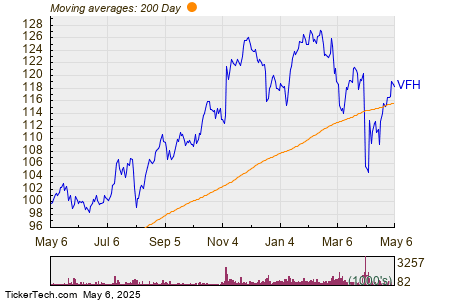Vanguard Financials ETF Sees Significant Outflow of $355.6 Million
Week-Over-Week Changes in ETF Shares Outstanding
In the latest analysis of week-over-week changes in shares outstanding for ETFs, the Vanguard Financials ETF (Symbol: VFH) has emerged as a notable example. It experienced an outflow of approximately $355.6 million, representing a 3.0% decrease in shares outstanding, which dropped from 100,630,890 to 97,635,414.
Current Performance of Key Holdings
Among the largest components of VFH, Intercontinental Exchange Inc (Symbol: ICE) has seen a modest increase of about 0.4%. Aon plc (Symbol: AON) rose approximately 0.6%, while Moody’s Corp. (Symbol: MCO) remained relatively unchanged.
VFH Price Performance Against Moving Average
The chart below illustrates the one-year price performance of VFH compared to its 200-day moving average:

Currently, VFH’s share price is at $118.47, situated between its 52-week low of $97.83 and its 52-week high of $127.67. Evaluating the most recent price in relation to the 200-day moving average can be an effective technical analysis tactic.
Understanding ETF Unit Trading
ETFs trade similarly to stocks, with investors purchasing and selling ‘units’ instead of ‘shares’. These units are exchanged just like stocks but can also be created or destroyed based on investor demand. Weekly monitoring of shares outstanding highlights ETFs with notable inflows (new units created) or outflows (old units destroyed). Creation of new units necessitates acquiring the underlying holdings, while the destruction involves selling those holdings, which can impact the individual components of the ETFs.
For further insights, click here to discover nine other ETFs experiencing significant outflows.
Additional Resources:
- ARAY Options Chain
- Institutional Holders of CLVR
- Top Ten Hedge Funds Holding EASI
The views and opinions expressed herein are those of the author and do not necessarily reflect those of Nasdaq, Inc.

